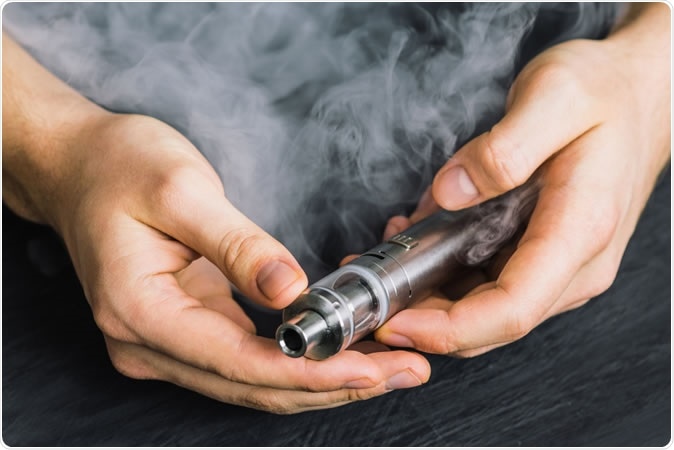
The background
The period from August to October 2019 saw almost 100 patients falling sick and in many cases dying of e-cigarette or vaping product use associated lung injury (EVALI) in Minnesota, while many others are being investigated. Almost 60 of these patients were asked about their use of tetrahydrocannabinol (THC) in vaping products, obtained from a variety of sources including family, friends, real or virtual stores. The investigators obtained samples of 46 products containing THC from 12 patients with EVALI and tested them using gas chromatography-mass spectrometry (GCMS) for a range of possible toxic compounds. This included vitamin E acetate which has been found in a few THC products as well in the lungs of EVALI patients.To find out whether this component had only recently begun to be added to THC-containing vaping products, the Minnesota Health Department subjected 10 samples from 2018 and 20 from 2019, all seized by law enforcement officers, in addition to the 46 obtained from EVALI patients themselves. The 2018 samples predated the first EVALI case while the others were obtained while the outbreak was occurring.
The findings reflected the presence of vitamin E acetate in 24/46 samples from EVALI patients, none from the 10 samples from 2018, and all products from 2019.
The conclusion
The small number of samples used in this study precludes any definitive conclusion as to whether it was the vitamin E acetate that indeed caused the lung injury. However, it is at least strongly suggestive that inhaled vitamin E acetate vapor may have contributed to the injury.The failure to detect vitamin E acetate in any product from 2018 but its detection in all products from 2019 suggests that this compound might have recently begun to be added as a filler or a diluent.
All Dank Vapes products that were tested proved positive for vitamin E acetate, whether obtained from patients or seized by law enforcement officers. In Minnesota, Utah, Wisconsin, and Illinois, most EVALI patients have reported that they used THC-containing products, and especially Dank Vapes, at percentages of up to 95%, and 75%, respectively.
The risk of using illicit vaping products containing THC was highest in patients with EVALI who were between 18-44 years of age. This group was also at the highest risk of using Dank Vapes products compared with a similar group who smoked THC-containing vapes but did not develop EVALI.
Other substances found on testing include medium-chain triglycerides, gamma-tocoferol, and alpha-tocoferol, as well as THC and nicotine. None showed the level of association as vitamin E acetate did. The scientists say that public health officers and law enforcement officials should come together to extend this study into THC-containing products that were on the market before and after the outbreak so as to understand how the product changes under market pressures, with possible effects on public health. The risk of using a product containing a toxicant is greater because of the existence of a free market with access to both formal and informal sources for the vaping product.
The gross differences that exist between products available from various supply chains and from various states means that the CDC continues to say e-cigarette products containing THC should not be used, as well as vaping products from other than formal stores. It also strongly advises against the use of vaping products by the following categories of people: youths, young adults, pregnant women.
Some limitations of this study are the small size; the impossibility of interviewing all EVALI patients if they refused consent, thus limiting its generalizability; the refusal of many of these patients to provide products they had used to the investigators for testing purposes; the limited number of samples that patients could provide on the spot, which fails to reflect the actual range of products that they actually used; the absence of sufficient material to carry out testing in many cases; and the limited range of testing, whereby only 10 compounds were screened for.
The use of THC-containing vaping products is thus not recommended until further notice, and it is also highly risky to smoke products from informal sources. Vitamin E acetate in a vaping product containing THC appears to have a more than incidental link with EVALI, but the researchers acknowledge several limitations of their study. Thus, immediate intensive large-scale research into the toxicants present in vaping products used by EVALI patients, the source of such products, and their interactions with lung tissue is required.
Journal reference:
Characteristics of e-cigarette, or vaping, products used by patients with associated lung injury and products seized by law enforcement - Minnesota, 2018 and 2019. Joanne Taylor, Terra Wiens, Jason Peterson, Stefan Saravia, Mark Lunda; Kaila Hanson, MS2; Matt Wogen; Paige D’Heilly, Jamie Margetta, Maria Bye, Cory Cole, Erica Mumm, Lauren Schwerzler, Roon Makhtal; Richard Danila, Ruth Lynfield, Stacy Holzbauer, and Lung Injury Response Task Force. MMWR Weekly Report, November 27, 2019 / 68(47);1096-1100. DOI: http://dx.doi.org/10.15585/mmwr.mm6847e1external icon.






No comments
Post a Comment